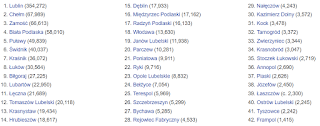Fortunately, only this voivodeship and three others to describe. I didn't want to write anymore 😂
Oh no, they changed the font size. And now it is much smaller than it was, sorry ;-;
******
13. LUBLIN
Lublin Voivodeship, or Lublin Province (PL: Województwo lubelskie) - is a voivodeship, or region, located in southeastern Poland. It was created on January 1, 1999, out of the former Lublin, Chełm, Zamość, Biała Podlaska and (partially) Tarnobrzeg and Siedlce Voivodeships, pursuant to Polish local government reforms adopted in 1998. The region is named after its largest city and regional capital, Lublin, and its territory is made of four historical lands: the western part of the voivodeship, with Lublin itself, belongs to Lesser Poland, the eastern part of Lublin Area belongs to Red Ruthenia, and the northeast belongs to Polesie and Podlasie.
Lublin Voivodeship borders Subcarpathian Voivodeship to the south, Holy Cross Voivodeship to the south-west, Masovian Voivodeship to the west and north, Podlaskie Voivodeship along a short boundary to the north, Belarus (Brest Region) and Ukraine (Lviv Oblast and Volyn Oblasts) to the east. The region's population as of 2006 was 2,175,251. It covers an area of 25,155 square kilometres (9,712 sq mi).
Only in Polish
Flag
Coat of arms
******
HISTORY
The Polish historical region that encompasses Lublin, and approximates Lublin Voivodeship as it was before the Partitions of Poland, is known as Lubelszczyzna. Provinces centred on Lublin have existed throughout much of Poland's history.
The region was, before World War II, one of the world's leading centres of Judaism. Before the middle of the 16th century, there were few Jews in the area, concentrated in Lublin, Kazimierz Dolny, and perhaps Chełm; but the founding of new private towns led to a large movement of Jews into the region to develop trade and services. Since these new towns competed with the existing towns for business, there followed a low-intensity, long-lasting feeling of resentment, with failed attempts to limit the Jewish immigration. The Jews tended to settle mostly in the cities and towns, with only individual families setting up businesses in the rural regions; this urban/rural division became another factor feeding resentment of the newly arrived economic competitors. By the middle of the 18th century, Jews were a significant part of the population in Kraśnik, Lubartów and Łęczna.
By the 20th century, Jews represented greater than 70% of the population in eleven towns and close to 100% of the population of Laszczów and Izbica. From this region came both religious figures such as Mordechai Josef Leiner of Izbica, Chaim Israel Morgenstern of Puławy, and Motele Rokeach of Biłgoraj, as well as famous secular authors Israel Joshua Singer. Israel's brother, the Nobel prize winner Isaac Bashevis Singer, was not born in Biłgoraj but lived part of his life in the city. The "Old Town" of the city of Lublin contained a famous yeshiva, Jewish hospital, synagogue, cemetery, and kahal, as well as the Grodzka Gate (known as the Jewish Gate).
Before the war, there were 300,000 Jews living in the region, which became the site of the Majdanek concentration camp and Bełżec extermination camp as well as several labour camps (Trawniki, Poniatowa, Budzyn, Puławy, Zamość, Biała Podlaska, and the Lublin work camps Lipowa 7 camp , Flugplatz, and Sportplatz) which produced military supplies for the Wehrmacht and Luftwaffe). This was once one of the biggest forced labour centres in occupied Europe, with approximately 45,000 Jewish prisoners. As well, the Sobibór extermination camp was located in the Lublin Voivodeship. After the war, the few surviving Jews largely left the area; today there is some restoration of areas of Jewish historical interest, and a surge of tourism by Jews seeking to view their families' historical roots.
******
CITIES AND TOWNS
The voivodeship contains 42 cities and towns. These are listed below in descending order of population (according to official figures for 2006):
******
ADMINISTRATIVE DIVISION
Lublin Voivodeship is divided into 24 counties (powiats): 4 city counties and 20 land counties. These are further divided into 213 gminas.
The counties are listed in the following table (ordering within categories is by decreasing population).
You must zoom in to have good quality
******
PROTECTED AREAS
- Polesie National Park (this and surrounding areas form the West Polesie biosphere reserve designated by UNESCO in 2002)
- Roztocze National Park
- Chełm Landscape Park
- Janów Forests Landscape Park - partly in Subcarpatian Voivodeship
- Kazimierz Landscape Park
- Kozłówka Landscape Park
- Kransobród Landscape Park
- Łęczna Lake District Landscape Park
- Podlaskie Bug Gorge Landscape Park - partly in Masovian Voivodeship
- Polesie Landscape Park
- Puszcza Solska Landscape Park - partly in Subcarpatian Voivodeship
- Skierbieszów Landscape Park
- Sobibór Landscape Park
- South Roztocze Landscape Park - partly in Subcarpatian Voivodeship
- Strzelce Landscape Park
- Szczebrzeszyn Landscape Park
- Wieprz Landscape Park
- Wrzelowiec Landscape Park
******
ECONOMY
The Gross domestic product (PKB) of the province was 18.5 billion euros in 2018, accounting for 3.7% of Polish economic output. PKB per capita adjusted for purchasing power was 14,400 euros or 48% of the EU27 average in the same year. The PKB per employee was 54% of the EU average. Lublin Voivodship is the province with the lowest PKB per capita in Poland.
******
MOST COMMON SURNAMES IN THE REGION
- Wójcik - 12,937
- Mazurek - 9,644
- Mazur - 8,019
******
PREVIOUS LUBLIN VOIVODESHIP
1474-1795
1816-1837
1919-1939
1945-1975
1975-1998
Lublin Voivodeship existed as one of Poland's 49 voivodeships from 1975 until 1998, when it was incorporated into the current (larger) Lublin Voivodeship.
******
More information and photos here:
CREDITS TO ARTIST for photos and articles from Wikipedia







No comments:
Post a Comment